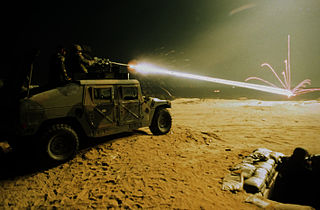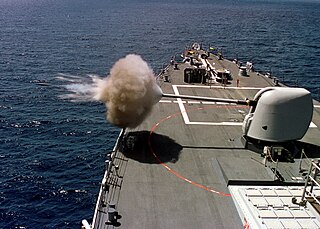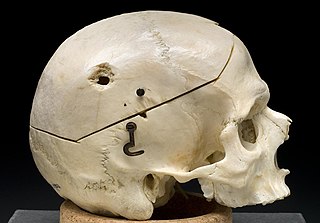Related Research Articles

Hydrostatic shock is the controversial concept that a penetrating projectile can produce a pressure wave that causes "remote neural damage", "subtle damage in neural tissues" and/or "rapid incapacitating effects" in living targets. It has also been suggested that pressure wave effects can cause indirect bone fractures at a distance from the projectile path, although it was later demonstrated that indirect bone fractures are caused by temporary cavity effects.

A bullet is a kinetic projectile, a component of firearm ammunition that is shot from a gun barrel. Bullets are made of a variety of materials, such as copper, lead, steel, polymer, rubber and even wax. Bullets are made in various shapes and constructions, including specialized functions such as hunting, target shooting, training and combat. Bullets are often tapered, making them more aerodynamic. Bullet sizes are expressed by their weights and diameters in both imperial and metric measurement systems. For example: 55 grain .223 caliber bullets are of the same weight and caliber as 3.56 gram 5.56mm caliber bullets. Bullets do not normally contain explosives but strike or damage the intended target by transferring kinetic energy upon impact and penetration. Bullets shot by firearms can be used for target practice or to injure or kill animals or people.

A cartridge or a round is a type of pre-assembled firearm ammunition packaging a projectile, a propellant substance and an ignition device (primer) within a metallic, paper, or plastic case that is precisely made to fit within the barrel chamber of a breechloading gun, for the practical purpose of convenient transportation and handling during shooting. Although in popular usage the term "bullet" is often informally used to refer to a complete cartridge, it is correctly used only to refer to the projectile.

In firearms, rifling is machining helical grooves into the internal (bore) surface of a gun's barrel for the purpose of exerting torque and thus imparting a spin to a projectile around its longitudinal axis during shooting to stabilize the projectile longitudinally by conservation of angular momentum, improving its aerodynamic stability and accuracy over smoothbore designs.

Terminal ballistics is a sub-field of ballistics concerned with the behavior and effects of a projectile when it hits and transfers its energy to a target.

The single-bullet theory, often derided and discredited by referring to it as the magic-bullet theory, was introduced by the Warren Commission in its investigation of the assassination of U.S. President John F. Kennedy to explain what happened to the bullet that struck Kennedy in the back and exited through his throat. Given the lack of damage to the presidential limousine consistent with it having been struck by a high-velocity bullet, and the fact that Texas Governor John Connally was wounded and was seated on a jumper seat 1+1⁄2 feet in front of and slightly to the left of the president, the Commission concluded they were likely struck by the same bullet.

A ricochet is a rebound, bounce, or skip off a surface, particularly in the case of a projectile. Most ricochets are caused by accident and while the force of the deflection decelerates the projectile, it can still be energetic and almost as dangerous as before the deflection. The possibility of ricochet is one of the reasons for the common firearms safety rule "Never shoot at a flat, hard surface." Ricochets can occur with any caliber, and short or round ricocheting bullets may not produce the audible whine caused by tumbling irregular shapes. Ricochets are a hazard of shooting because, for as long as they retain sufficient velocity, ricocheting bullets or bullet fragments may cause collateral damage to animals, objects, or even the person who fired the shot.

External ballistics or exterior ballistics is the part of ballistics that deals with the behavior of a projectile in flight. The projectile may be powered or un-powered, guided or unguided, spin or fin stabilized, flying through an atmosphere or in the vacuum of space, but most certainly flying under the influence of a gravitational field.

Ballistic gelatin is a testing medium designed to simulate the effects of bullet wounds in animal muscle tissue. It was developed and improved by Martin Fackler and others in the field of wound ballistics. It is calibrated to match porcine muscle, which is itself ballistically similar to human muscle tissue.

A gun barrel is a crucial part of gun-type weapons such as small firearms, artillery pieces and air guns. It is the straight shooting tube, usually made of rigid high-strength metal, through which a contained rapid expansion of high-pressure gas(es) is used to propel a projectile out of the front end (muzzle) at a high velocity. The hollow interior of the barrel is called the bore, and the diameter of the bore is called its caliber, usually measured in inches or millimetres.

A gunshot is a single discharge of a gun, typically a man-portable firearm, producing a visible flash, a powerful and loud shockwave and often chemical gunshot residue. The term can also refer to a ballistic wound caused by such a discharge.

The .22 Long Rifle or simply .22 LR is a long-established variety of .22 caliber rimfire ammunition originating from the United States. It is used in a wide range of rifles, pistols, revolvers, smoothbore shotguns, and submachine guns.
Internal ballistics, a subfield of ballistics, is the study of the propulsion of a projectile.

A blank is a firearm cartridge that, when fired, does not shoot a projectile like a bullet or pellet, but generates a muzzle flash and an explosive sound like a normal gunshot would. Firearms may need to be modified to allow a blank to cycle the action, and the shooter experiences less recoil with a blank than with a live round. Blanks are often used in prop guns for shooting simulations that have no need for ballistic results, but still demand light and sound effects, such as in historical reenactments, special effects for theatre, movie and television productions, combat training, for signaling, and cowboy mounted shooting. Specialised blank cartridges are also used for their propellant force in fields as varied as construction, shooting sports, and fishing and general recreation.

Transitional ballistics, also known as intermediate ballistics, is the study of a projectile's behavior from the time it leaves the muzzle until the pressure behind the projectile is equalized, so it lies between internal ballistics and external ballistics.
Stopping power is the ability of a weapon – typically a ranged weapon such as a firearm – to cause a target to be incapacitated or immobilized. Stopping power contrasts with lethality in that it pertains only to a weapon's ability to make the target cease action, regardless of whether or not death ultimately occurs. Which ammunition cartridges have the greatest stopping power is a much debated topic.

A contact shot is a gunshot wound incurred while the muzzle of the firearm is in direct contact with the body at the moment of discharge. Contact shots are often the result of close range gunfights, suicide, or execution.

A gunshot wound (GSW) is a penetrating injury caused by a projectile from a gun. Damages may include bleeding, bone fractures, organ damage, wound infection, loss of the ability to move part of the body and, in more severe cases, death. Damage depends on the part of the body hit, the path the bullet follows through the body, and the type and speed of the bullet. Long-term complications can include lead poisoning and post-traumatic stress disorder (PTSD).

Penetrating trauma is an open wound injury that occurs when an object pierces the skin and enters a tissue of the body, creating a deep but relatively narrow entry wound. In contrast, a blunt or non-penetrating trauma may have some deep damage, but the overlying skin is not necessarily broken and the wound is still closed to the outside environment. The penetrating object may remain in the tissues, come back out the path it entered, or pass through the full thickness of the tissues and exit from another area.

A silencer, also known as a sound suppressor, suppressor or sound moderator, is a muzzle device that reduces the acoustic intensity of the muzzle report and the recoil when a gun is discharged, by modulating the speed and pressure of the propellant gas from the muzzle and hence suppressing the muzzle blast. Like other muzzle devices, a silencer can be a detachable accessory mounted to the muzzle, or an integral part of the barrel.
References
- 1 2 3 4 5 "Gunshot wounds - rifled weapons". Forensic Medicine for Medical Students. Archived from the original on 11 December 2018. Retrieved 9 June 2019.
- ↑ Gujaral, PB; Ajay, B (28 February 2017). "Abrasion Collar Around Shrapnel Entry Wound". J Forensic Sci. 62 (6): 1635–1637. doi:10.1111/1556-4029.13457. PMID 28244192. S2CID 4802864.
- 1 2 3 4 Rao, Dinesh. "Firearm injuries". Dr Dinesh Rao's Forensic Pathology. Archived from the original on 19 March 2019. Retrieved 10 June 2019.
- ↑ Aguilar, JC (September 1983). "Shored gunshot wound of exit. A phenomenon with identity crisis". Am J Forensic Med Pathol. 4 (3): 199–204. doi:10.1097/00000433-198309000-00003. PMID 6637946.
- ↑ Pircher, R; Pollak, S; Preiß, D; Thierauf-Emberger, A; Perdekamp, MG; Geisenberger, D (March 2017). "The influence of the bullet shape on the width of abrasion collars and the size of gunshot entrance holes". Int J Legal Med. 131 (2): 441–445. doi:10.1007/s00414-016-1501-6. PMID 27909866. S2CID 1772305.
- ↑ Peonim, V; Srisont, S; Udnoon, J; Wongwichai, S; Thapon, A; Worasuwannarak, W (November 2016). "Entrance and exit wounds of high velocity bullet: An autopsy analysis in the event of dispersing the mass rally in Bangkok Thailand, May 2010". Leg Med (Tokyo). 23: 10–16. doi:10.1016/j.legalmed.2016.08.010. PMID 27890096.